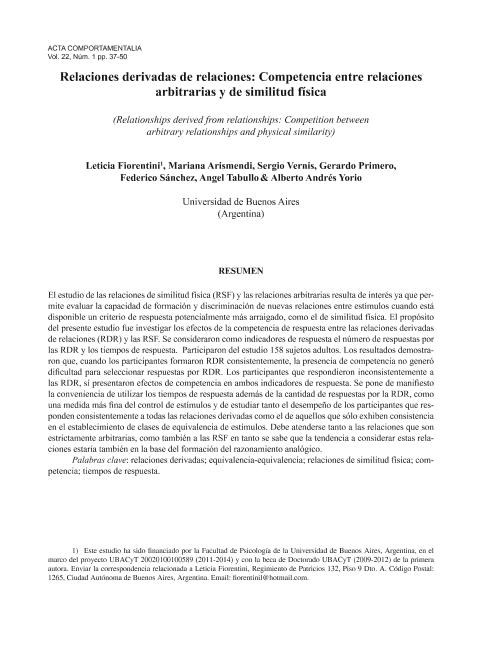Artículo
El estudio de las relaciones de similitud física (RSF) y las relaciones arbitrarias resulta de interés ya que permite evaluar la capacidad de formación y discriminación de nuevas relaciones entre estímulos cuando está disponible un criterio de respuesta potencialmente más arraigado, como el de similitud física. El propósito del presente estudio fue investigar los efectos de la competencia de respuesta entre las relaciones derivadas de relaciones (RDR) y las RSF. Se consideraron como indicadores de respuesta el número de respuestas por las RDR y los tiempos de respuesta. Participaron del estudio 158 sujetos adultos. Los resultados demostraron que, cuando los participantes formaron RDR consistentemente, la presencia de competencia no generó dificultad para seleccionar respuestas por RDR. Los participantes que respondieron inconsistentemente a las RDR, sí presentaron efectos de competencia en ambos indicadores de respuesta. Se pone de manifiesto la conveniencia de utilizar los tiempos de respuesta además de la cantidad de respuestas por la RDR, como una medida más fina del control de estímulos y de estudiar tanto el desempeño de los participantes que responden consistentemente a todas las relaciones derivadas como el de aquellos que sólo exhiben consistencia en el establecimiento de clases de equivalencia de estímulos. Debe atenderse tanto a las relaciones que son estrictamente arbitrarias, como también a las RSF en tanto se sabe que la tendencia a considerar estas relaciones estaría también en la base del formación del razonamiento analógico. The study of physical similarity relationships (PSR) and arbitrary relationships is of interest because it allows the assessment of the ability to form and discriminate new relationships between stimuli when another response criterion more established is potentially available, like that of physical similarity. The importance of this type of relational responding is that this behavior is similar to that of analogical reasoning and its study has the advantage of allowing systematic control of familiarity and stimulus learning. The relationships derived from relationships (RDR) imply the ability to establish relationships based not on the stimulus, but on the relations established between combinations of stimuli. In this sense, it is necessary to address both the relationships that are strictly arbitrary as well as PSR, as it is known that the tendency to consider these relationships would also be the basis for the formation of analogical reasoning. The purpose of this study was to investigate the effects of response competition between the RDR and the PSR. The number of responses by the RDR and response times were considered as indicators of response. The study included 158 adult subjects. The results showed that when participants formed RDR consistently, the presence of competition did not cause difficulties in selecting responses by RDR. By contrast, participants who responded inconsistently to the RDR did show effects of competition in both indicators of response. The advantage of using the response times in addition to the number of responses by the RDR is shown as a finer measure of stimulus control. In turn, a special emphasis is made on the importance of studying both the performance of the participants who responded consistently to all derived relations as well as those that only exhibit consistency in establishing stimulus equivalence classes.
Relaciones derivadas de relaciones: competencia entre relaciones arbitrarias y de similitud física
Título:
Relationships derived from relationships: Competition between arbitrary relationships and physical similarity
Fiorentini, Leticia ; Arismendi, Mariana; Vernis, Sergio; Primero, Gerardo; Sánchez, Federico José; Tabullo, Angel Javier
; Arismendi, Mariana; Vernis, Sergio; Primero, Gerardo; Sánchez, Federico José; Tabullo, Angel Javier ; Iorio, Alberto Andres
; Iorio, Alberto Andres
 ; Arismendi, Mariana; Vernis, Sergio; Primero, Gerardo; Sánchez, Federico José; Tabullo, Angel Javier
; Arismendi, Mariana; Vernis, Sergio; Primero, Gerardo; Sánchez, Federico José; Tabullo, Angel Javier ; Iorio, Alberto Andres
; Iorio, Alberto Andres
Fecha de publicación:
01/2014
Editorial:
Universidad de Guadalajara
Revista:
Acta Comportamentalia
ISSN:
0188-8145
Idioma:
Español
Tipo de recurso:
Artículo publicado
Clasificación temática:
Resumen
Palabras clave:
Equivalencia-Equivalencia
,
Similitudfísica
,
Competencia
,
Tiemposderespuesta
Archivos asociados
Licencia
Identificadores
Colecciones
Articulos(IBYME)
Articulos de INST.DE BIOLOGIA Y MEDICINA EXPERIMENTAL (I)
Articulos de INST.DE BIOLOGIA Y MEDICINA EXPERIMENTAL (I)
Articulos(INCIHUSA)
Articulos de INST. DE CS. HUMANAS, SOC. Y AMBIENTALES
Articulos de INST. DE CS. HUMANAS, SOC. Y AMBIENTALES
Citación
Fiorentini, Leticia; Arismendi, Mariana; Vernis, Sergio; Primero, Gerardo; Sánchez, Federico José; et al.; Relaciones derivadas de relaciones: competencia entre relaciones arbitrarias y de similitud física; Universidad de Guadalajara; Acta Comportamentalia; 22; 1; 1-2014; 37-50
Compartir



